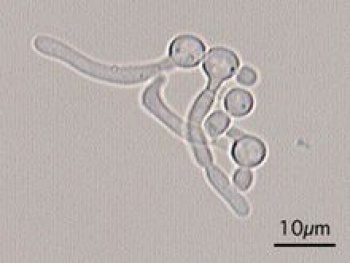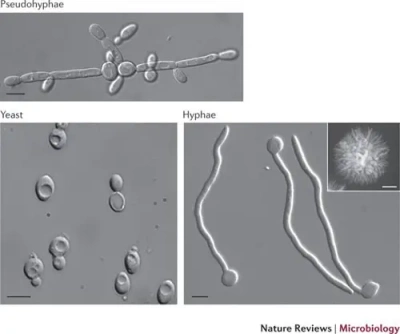Germ Tube Test - Principle, Purpose, Procedure, Result, Interpretation, Limitation
Introduction to Germ Tube Test
The germ tube test is a rapid, diagnostic test in which sample fungal spores are suspended in animal serum or egg albumin for three hours and microscopically examined for production of germ tubes. Other factors such as temperature, inoculum, strain, and medium also affect test tube production.
This screening test is mostly done to differentiate Candida albicans from other yeasts. Germ tube is one of the most important virulence factors for Candida albicans.
The germ tubes create somatic hyphae by the process of mitosis. This is done mostly when fungal culture produces colonies of white or cream color.

Germ tubes formed by Candida albicans
History of Germ Tube Test
The formation of the germ tube was first reported in 1956 by Reynolds and Braude.
Principle of Germ Tube Test
Germ tubes are short outgrowths that are non-septate germinating hyphae. During germination, spore-producing fungi produce an outgrowth called the germ tube from its spores – in the presence of tryptic soy broth, fetal bovine serum, and other essential nutrients for protein synthesis. The formation of the germ tube is due to an increase in the synthesis of protein and ribonucleic acid.
These germ tubes can be detected by the KOH mount films where filamentous outgrowths can be observed extending from yeast cells.
Purpose of Germ Tube Test
The germ tube test is a screening test used to differentiate Candida albicans from other yeasts. Approximately 95 – 97% of Candida albicans produce germ tubes during the germ tube test. Germ tube is also produced by Candida dubliniensis.

(a) Germ Tube Formation in Candida albicans; (b) Candida tropicalis blastoconidial germination with constriction
Procedure of Germ Tube Test
The procedure of the Germ Tube Test is as follows:
In a small test tube, take 0.5 ml of animal serum (sheep, human, or fetal bovine serum).
Use a sterile Pasteur pipette to gently touch a colony of yeast to be identified and gently emulsify in the serum.
* Do not take large inoculum as it may inhibit germ tube formation due to lack of serum.
Incubate the inoculated serum at 37°C for 2 to 4 hours.
Perform the KOH mount on a clean grease-free slide.
Transfer a drop of serum to the slide.
Place a coverslip and examine it under the microscope under low and high-power objectives.
Result, Interpretation of Germ Tube Test
Positive Germ Tube Test:
The presence of a short hyphal (filamentous) extension arising from a yeast cell is interpreted as a positive germ tube test. There is no constriction (septum) at the point of origin of the cell in the germ tube which is half the with and 3-4 times the length of the parent yeast cell. Nucleus is absent.
Example: Candida albicans and Candida dubliniensis produce germ tubes.
Negative Germ Tube Test:
The absence of hyphal (filamentous) extension arising from a yeast cell. A short hyphal extension with constriction at the point of origin is also regarded as a negative germ tube test.
Example: Candida tropicalis, Candida glabrata, and other yeasts.

Candida albicans
Limitation of Germ Tube Test
Since the Germ Tube Test is a screening test, further testing is required for a definitive diagnosis.
Some strains of Candida tropicalis may produce pseudohyphae which may be misinterpretated as germ tubes.
Candida dubliniensis, an opportunistic fungal pathogen, also produces germ tubes so false positives can occur.
Too heavy inoculum can inhibit the formation of the germ tube.